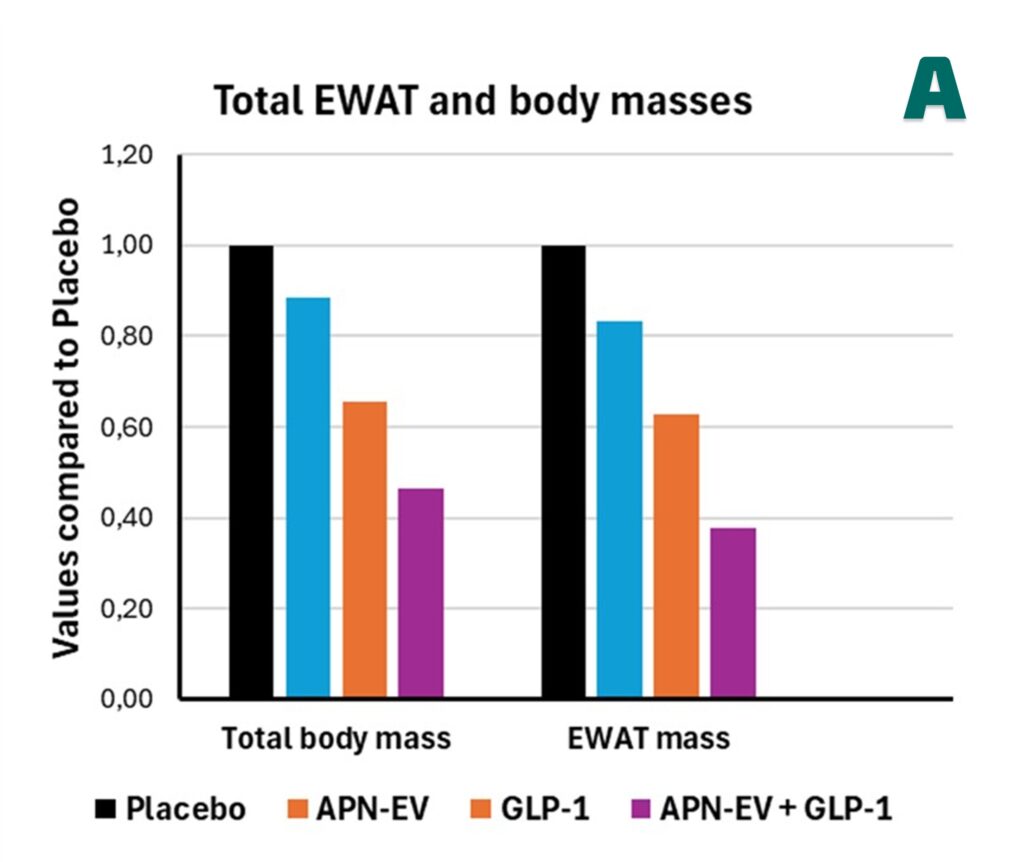A bio-therapeutic to tackle obesity
Acting on pathways complementary to GLP-1, APN-sEVS are perfect GLP-1R co-agonists
Overview
Obesity (BMI > 30) is a complex, multifactorial pathology. It is not simply a matter of being overweight. This chronic disease is progressing at an alarming rate worldwide, with the number of cases doubling since 1990 among adults and quadrupling among adolescents, according to the WHO. Eating habits and a more sedentary lifestyle are major factors contributing to weight-related disorders by creating an energy imbalance between calories consumed and burned daily. Obesity represents a major risk factor for many common chronic pathologies : osteoarthritis, type 2 diabetes, cardiovascular disease, sleep apnea, musculoskeletal disorders metabolic dysfunctions associated with non-alcoholic steatohepatitis (MASH).


Current treatments
Overview.
The most efficient treatment against obesity are based on GLP-1 receptor agonists (GLP-1-RAs) that are efficient for both blood sugar control and weight loss. Some are also approved for T2D treatment and MASLD. They may induce common gastrointestinal adverse effects, and reduce lean body mass; their discontinuation leads to reversal of benefits, including weight gain and increased blood glucose levels, necessitating continuous treatment. Therapeutic strategies are moving towards dual or triple agonists targeting both GLP-1 and GIP receptors, which may offer better efficacy than single-receptor treatments, though adverse effects are still common.
The high cost of these lifelong treatments represents a barrier that limits access for some patients, particularly in healthcare systems where reimbursement is partial or non-existent.
Interestingly, the anti-obesity treatments increase adiponectin levels, which may contribute to their beneficial effects on insulin sensitivity and metabolic health. This observation suggests that adiponectin itself may be a key molecule in the treatment of obesity.
Adiponectin beneficial effects
- Serum levels of adiponectin decrease with obesity.
- Serum levels of adiponectin are positively associated with insulin sensitivity. [1]
- Adiponectin-deficient mice exhibit obesity, insulin resistance, and inflammation. Conversely, overexpressing adiponectin in these models leads to reduced fat accumulation and improved metabolic function.
[1] Berg AH et al. Nat Med. 2001. doi: 10.1038/90992.
Adiponectin Mode of Action in Obesity
INSULIN SENSITIVIZING EFFECTS
Adiponectin enhances insulin sensitivity, particularly in skeletal muscles and the liver. It increases fatty acid oxidation and reduces fat storage in adipocytes. These mechanisms help to reduce insulin resistance, a hallmark of obesity and type 2 diabetes.
ANTI-INFLAMMATORY PROPERTIES
Obesity is often accompanied by chronic low-grade inflammation, driven by immune cells in adipose tissue. By inhibiting the expression of pro-inflammatory cytokines (TNF-α and IL-6), adiponectin exerts anti-inflammatory effects.
FAT DISTRIBUTION
Adiponectin promotes the storage of fat in subcutaneous adipose tissue rather than visceral fat. Visceral fat is particularly harmful because it contributes to insulin resistance, cardiovascular disease, and metabolic complications.
Adiponectin on sEVs (APN-sEVs) tackles obesity
Treating obese/diabetic mice with APN-sEVs induces body weight loss and reduces fat storage.
Notably, unlike other weight-loss treatments, there is no simultaneous loss of muscle mass.
These effects are dramatically enhanced by combining APN-sEVs with GLP-1RA, resulting in complete clearance of visceral fat and adipocytes from muscles.
While GLP-1RA treatment is known to result in lean mass loss, co-injection with APN-sEVs results in the preservation of all lean mass.
APN-sEVs therefore offer a unique therapeutic profile, providing a highly effective treatment for obesity without inducing adverse effects. This would be particularly advantageous for elderly patients.




